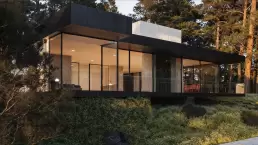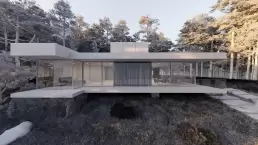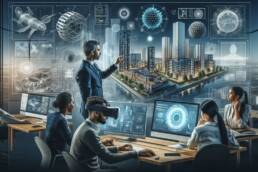Hi, in this blog we would like to talk a little bit about “The Essentials of 3D Visualization” & walk you through all the aspects of 3D Visualization. We hope this article will be useful for upcoming students and for Industry professionals as well.
Brief on 3D Visualization

3D visualization, synonymous with 3D rendering or CGI (Computer-Generated Imagery), represents a significant technological advancement in creating graphical content using sophisticated 3D software. This technique transcends traditional boundaries of visual representation, offering unparalleled accuracy and realism in digital imagery. Its versatility spans numerous industries, including architecture, engineering, automotive, and entertainment, making it a cornerstone of modern digital creativity.
The Art and Science Behind 3D Visualization
At its core, 3D visualization marries the precision of technical skill with the nuance of artistic interpretation. Unlike straightforward photography, it demands a deep understanding of both the tools of the trade and the principles of aesthetic appeal. Programs such as Autodesk 3ds Max, Blender, and Maya serve as the canvases upon which artists bring their visions to life, long before the first physical counterpart is constructed. This pre-visualization capability not only aids in design and planning but also in communicating complex concepts and designs with clarity and impact.
Detailed Process of 3D Visualization

- Conceptualization: The journey begins with a clear understanding of the project’s goals and requirements. This stage involves extensive collaboration with clients or other stakeholders to align visions and expectations.
- Modeling: Utilizing 3D software, the visualization artist creates the structural blueprint of the scene. This involves sculpting the geometry of objects, architecture, or landscapes, ensuring every detail aligns with the conceptual vision.
- Texturing and Material Creation: This phase imbues the models with realism through the application of textures and materials. Artists carefully select or create surfaces that accurately reflect real-world characteristics, from roughness and glossiness to translucency and color.
- Lighting: Arguably one of the most crucial steps, lighting sets the mood and atmosphere of the scene. Techniques vary from global illumination for natural light replication to targeted lighting setups that highlight specific features or create dramatic effects.
- Rendering: This computationally intensive step brings everything together. Using advanced software like V-Ray or Keyshot, the scene is processed to produce the final image or sequence. This stage requires a keen eye for detail and a thorough understanding of rendering techniques to achieve photorealistic results.
- Post-Production: The rendered images often undergo further refinement in post-production, where color correction, compositing, and effects are applied to enhance the visual impact and convey the desired message effectively.
Incorporating Human Interest and Real-World Impact
1. Personal Stories from 3D Artists
Dive into the personal journeys of 3D artists by sharing their narratives. These stories can revolve around the intricate challenges they faced while working on ambitious projects and the triumphant moments of seeing their visions come to life. For instance, an artist could recount the experience of working on a complex architectural visualization that was instrumental in securing approval from a city council, highlighting both the technical hurdles and the creative satisfaction of the task.
2. Impact on Society
Explore the profound implications of 3D visualization across societal fronts. For medical visualization, discuss how it’s revolutionizing patient care and education, allowing medical professionals and students to explore human anatomy in a detailed and interactive manner. Highlight the role of 3D visualization in environmental conservation, such as simulating the effects of climate change on natural habitats, which can be a powerful tool in raising awareness and driving action.
Broadening the Scope to Related Fields
1. Integration with Other Technologies
Illustrate how 3D visualization is synergizing with technologies like 3D printing, VR, and AR to create immersive and interactive experiences. Detail a case where architectural models visualized in VR allowed stakeholders to ‘walk through’ a building before its construction, enhancing decision-making processes and client satisfaction.
2. Cross-Industry Collaborations
Showcase examples of cross-industry collaborations that highlight the versatility of 3D visualization. You might discuss a fashion designer who uses 3D visualization to create virtual fashion shows or a chef who collaborates with visual artists to create an immersive dining experience, blending culinary arts with visual storytelling.
Enhancing Reader Interaction and Learning
1. Interactive Elements
Suggest the integration of interactive 3D models on your blog. This can provide an interactive learning experience, allowing readers to engage directly with the content. For example, embedding a 3D model of a mechanical part that users can rotate and disassemble to understand its workings can significantly enhance comprehension and engagement.
2. Learning Resources
Offer a comprehensive list of resources for readers interested in 3D visualization. This can include online courses from platforms like Udemy or Coursera, specialized forums like CGSociety, and essential books that cover the basics and advanced techniques. Highlighting both free and premium resources ensures that learners at all levels find something valuable.
Detailed Exploration of Subspecialties
1. Focus on Niches
Delve into the niches within 3D visualization, such as character modeling, architectural visualization, and product design. Discuss the unique skills required for each area, the typical projects one might work on, and the career opportunities available. Sharing insights into these specialties can guide readers in finding their passion or next career move.
2. Technique Spotlights
Feature in-depth articles on specific techniques or technologies pivotal to 3D visualization. For instance, an article could explore how procedural generation is used to create complex natural environments with a high degree of realism, or how fluid dynamics simulations are crucial in visual effects for film and television.
Regular Content Features
1. Artist Spotlight
Initiate a recurring segment that profiles a 3D visualization artist, showcasing their portfolio and offering insights into their creative process. This not only celebrates individual talent but also inspires the community by demonstrating the diverse applications of 3D visualization skills.
2. Project Breakdowns
Provide detailed analyses of notable 3D visualization projects, focusing on the challenges encountered and the innovative solutions adopted. This could range from the technical details of achieving photorealistic lighting in a rendering to the creative solutions for conveying complex architectural concepts to a lay audience.
The Impact of 3D Visualization
The impact of 3D visualization transcends a broad spectrum of fields, fundamentally altering the way we interact with and understand the world around us. In the spheres of architecture, product design, entertainment, and automotive industries, the ability to pre-visualize in three dimensions has been nothing short of revolutionary. It allows for a tangible understanding and exploration of concepts that have yet to be physically realized, providing a vital tool for innovation and communication.
1. In Architecture and Urban Planning
Architects and urban planners can now design with an unprecedented level of precision and creativity. 3D visualization tools enable them to conceive, refine, and share their visions in a manner that is both intuitive and demonstrative, ensuring that what is imagined can be more accurately brought into reality. They can forecast the environmental impact of a new development, assess how a structure will complement or disrupt the existing skyline, and even predict potential challenges that might arise long before breaking ground.
2. In Product Design and Manufacturing
The manufacturing sector has also been drastically reshaped by 3D visualization. It has enabled the creation of complex product prototypes without the need for costly materials or the risk of wastage. Manufacturers can analyze the functionality, aesthetics, and feasibility of a product and make necessary adjustments with a few clicks, reducing the product development cycle and accelerating time to market.
3. In the Automotive Industry
The automotive industry relies heavily on 3D visualization not just for design and conceptualization but also in the marketing of new vehicles. Before a single car is built, manufacturers can create a comprehensive portfolio of photorealistic images and animations of new models, facilitating earlier and more effective marketing campaigns.
4. In Entertainment and Media
The entertainment industry perhaps showcases the most dazzling applications of 3D visualization. Entire worlds are constructed with intricate detail, characters are brought to life, and impossible scenes are rendered believable. This has expanded the creative horizons for filmmakers, game designers, and digital media professionals, providing tools to tell stories in new and immersive ways.
The Future of 3D Visualization
Looking ahead, the trajectory of 3D visualization is set to soar to even greater heights. Emerging technologies such as virtual reality (VR), augmented reality (AR), and artificial intelligence (AI) are on course to further revolutionize this domain. We are heading towards a future where immersive experiences are commonplace, and the lines between the physical and digital worlds become increasingly blurred. VR and AR promise to offer even more immersive and interactive experiences, allowing for real-time exploration and manipulation of 3D visualizations. AI could automate and optimize various aspects of the 3D visualization process, making it faster and more intuitive.
Furthermore, with the integration of real-time rendering and the advancement of cloud computing, 3D visualizations are becoming more accessible, enabling collaborative design and review processes on a global scale. The future also hints at more democratized creation tools, with platforms allowing individuals without extensive technical training to craft detailed 3D representations.
The integration of 3D visualization into the Internet of Things (IoT) and Big Data could provide detailed simulations for urban planning, environmental monitoring, and the expansion of smart cities. The potential for predictive modeling and scenario planning in 3D environments could lead to significant advancements in sustainability and disaster management.
In essence, the maturation of 3D visualization stands as a testament to human ingenuity, continuing to blend the boundaries of art and science. As the tools evolve, so too does our capability to shape, share, and understand our creations, paving the way for innovations that will define the landscapes of tomorrow.
Get your project estimated within 60 minutes - simply send us your project brief!
Conclusion
As practitioners and innovators in the field of 3D visualization, our company is dedicated to pushing the boundaries of what is possible. Our multidisciplinary team of artists leverages the latest tools and techniques to create stunning visualizations that bring ideas to life. We invite you to explore our portfolio, where our commitment to quality and innovation is on full display. Through our work, we not only aim to enhance the visual landscape of our clients’ projects but also to contribute to the ever-evolving art and science of 3D visualization.
We hope you like this short description of our Industry.
Thank you.



